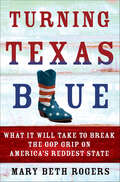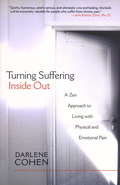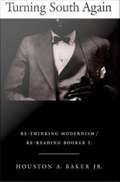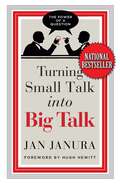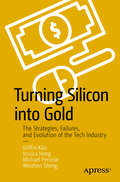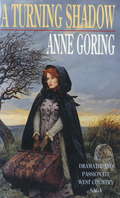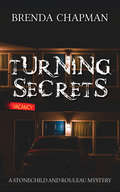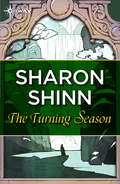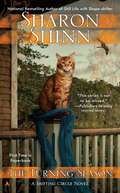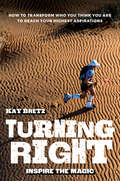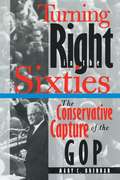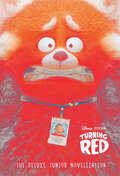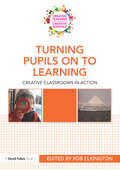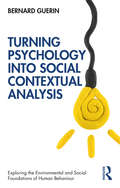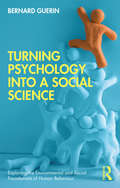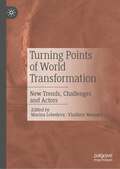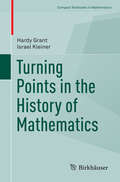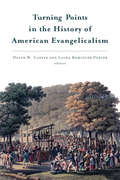- Table View
- List View
Turning Texas Blue: What It Will Take to Break the GOP Grip on America's Reddest State
by Mary Beth RogersIn the 2014 midterm election, Democrats in Texas did not receive even 40 percent of the statewide vote; Republicans swept the tables both in Texas and nationally. But even after two decades of democratic losses, there is a path to turn Texas blue, argues Mary Beth Rogers - if Democrats are smart enough to see and follow it. Rogers is the last person to successfully campaign-manage a Democrat, Governor Ann Richards, to the statehouse in Austin. In a lively narrative, Rogers tells the story of how Texas moved so far to the right in such a short time and how Democrats might be able to move it back to the center. And, argues Rogers, that will mean a lot more of an effort than simply waiting for the state's demographics to shift even further towards Hispanics - a risky proposition at best. Rogers identifies a ten-point path for Texas Democrats to win at the statewide level and to build a base vote that would allow Texas to become a swing-vote player in national politics once again. One part of that shift starts with local Democratic candidates in local Republican communities making the connection between controversial local issues or problems and the statewide Republican policies that ignore or create them. For example, in a 2014 election in Denton-a Republican suburb-voters approved Texas's first ban on hydraulic fracking. The next day, though, a Republican Texas agency official announced that Texas would not honor the town's vote to ban. No democratic candidate picked up the issue. Change won't come easily, argues Rogers. But if Texas shifts to even a pale shade of purple, it changes everything in American politics today.
Turning Tension into a Productive Force
by Vijay Govindarajan Chris TrimbleNew York Times Digital is profitable and continues to grow because its organizational design allows forgetting and borrowing simultaneously. This chapter suggests specific roles and responsibilities for a senior executive responsible for ensuring the effectiveness of six types of operational links between NewCo and CoreCo.
Turning Teaching Inside Out
by Simone Weil Davis Barbara Sherr RoswellThe Inside-Out Prison Exchange Program brings campus-enrolled and incarcerated students together as classmates in postsecondary courses built around dialogue, collaboration, and experiential learning. Contributors to this book consider the broader lessons that Inside-Out provides for community-based learning praxis, prison education and postsecondary teaching in general, both on campus and in community settings. An international network of practitioner-scholars probe the challenges and contradictions inherent in community-based work, but especially charged in the prison setting: the intersections of race, class and gender, and the tensions between teaching and activism, evaluation and advocacy, and compromise with and resistance to oppressive and dehumanizing systems. At a time when many in the Academy are seeking to deepen the impact of the community-based learning initiatives on their campuses, Turning Teaching Inside Out offers a model.
Turning Talent into Stars: The Enduring Edge
by Jay W. Lorsch Thomas J. TierneyThe key to your firm's continuing success is building star talent--the only sustainable source of competitive advantage. In this chapter, the authors explain that "star making"--an organization's competency at attracting, retaining, developing, and motivating star talent--is an important core competency for building a firm's long-term success.
Turning Suffering Inside Out: A Zen Approach for Living with Physical and Emotional Pain
by Darlene CohenDarlene Cohen discovered the secret to finding happiness in the midst of debilitating pain. She shares her knowledge in her popular workshops and now in this book. Cohen, who has suffered from rheumatoid arthritis for eighteen years, was hobbling painfully to her local Zen center one day, when she made a discovery that changed her life: if she focused on the foot that was in the air rather than the one that was hitting the pavement, her stamina increased enormously. It was the beginning of a completely different approach to the crippling pain that had beset her for so long. As she demonstrates here, this approach can be expanded to all types of pain: physical, psychological, and spiritual. Cohen--a certified massage and movement therapist and Zen teacher--proposes a radically liberating alternative to the usual desperate search for pain relief: paradoxically, she says, release from suffering lies in paying closer attention to it. When we keep pain at bay, we keep pleasure at bay, too. The two are interdependent, and our ability to experience each is totally dependent on our understanding of the other. "Enrich your life exponentially," Cohen advises. If your pain is one of the ten things you are aware of, then it constitutes a tenth of your total awareness. Expand your awareness to a hundred things, however, and your pain is only a hundredth of your awareness. With stories, strategies, exercises, and an awareness born of long Zen practice, Cohen shows us how to tap into that enrichment--and how we can lead a satisfying and even joyful life in the very midst of pain. This book was published in hardcover under the title Finding a Joyful Life in the Heart of Pain.
Turning South Again: Re-thinking Modernism/Re-reading Booker T.
by Houston A. Baker Jr.In Turning South Again the distinguished and award-winning essayist, poet, and scholar of African American literature Houston A. Baker, Jr. offers a revisionist account of the struggle for black modernism in the United States. With a take on the work of Booker T. Washington and the Tuskegee Institute surprisingly different from that in his earlier book Modernism and the Harlem Renaissance, Baker combines historical considerations with psychoanalysis, personal memoir, and whiteness studies to argue that the American South and its regulating institutions--particularly that of incarceration--have always been at the center of the African American experience. From the holds of slave ships to the peonage of Reconstruction to the contemporary prison system, incarceration has largely defined black life in the United States. Even Washington's school at Tuskegee, Baker explains, housed and regulated black bodies no longer directly controlled by slave owners. He further implicates Washington by claiming that in enacting his ideas about racial "uplift," Washington engaged in "mulatto modernism," a compromised attempt at full citizenship. Combining autobiographical prose, literary criticism, psychoanalytic writing, and, occasionally, blues lyrics and poetry, Baker meditates on the consequences of mulatto modernism for the project of black modernism, which he defines as the achievement of mobile, life-enhancing participation in the public sphere and economic solvency for the majority of African Americans. By including a section about growing up in the South, as well as his recent return to assume a professorship at Duke, Baker contributes further to one of the book's central concerns: a call to centralize the South in American cultural studies.
Turning Sorrow Into Joy: A Journey of Faith and Perseverance
by Kent ChristmasRejected. Broke. Unsuccessful. These are not words one associate with a pastor whose church has more than 3,000 members and whose services and podcast are viewed online by more than 200,000 people in nearly 100 nations each week. But Pastor Kent Christmas has lived these words. Jobless, near penniless, and nearly killed, on more than one occasion . . . yet ever laboring to become all that God would have him to be. This was Kent&’s story. But God . . . God uses broken people with broken hearts and lives to bring healing and salvation to a broken world. In Turning Sorrow Into Joy, you will learn how God took Kent from floundering small-town preacher to world-renowned pastor, from brokenness to healing, from adversity to blessing, and from despair to victory. For Kent, God truly did restore the years that the locust had eaten (Joel 2:25). Are you struggling to fulfill what you believe to be God&’s purpose for your life but can&’t seem to gain any traction? Is your story one of heartache, betrayal, rejection, and struggle, and you fear that your past will be your future? Kent Christmas has been there, yet he triumphed against all odds. And so can you. Kent&’s story didn&’t end where it began. Read it and be encouraged. God has a plan for you. He will fulfill it in His time.
Turning Small Talk into Big Talk
by Jan JanuraIn Turning Small Talk into Big Talk, Jan Janura helps readers move below the surface and experience deep, meaningful conversations that are not only interesting, but even life-changing.Small talk is awful, awkward, and ultimately useless—and everyone knows it. When is the last time you had a significant conversation with your spouse, your kids, your best friend, your neighbor, or a close business associate? No, not small talk. We do enough of that with our fingers in five-word text &“conversations&” or in dull, surface-level, face-to-face interactions. Small talk isn&’t getting us anywhere. What we need today more than ever is &“Big Talk,&” real conversations in which we dig deep into our souls and discuss intriguing topics that truly shape the world and impact our daily lives. Conversation is undoubtedly the most important part of a relationship, whether it&’s business, personal, or spiritual. It&’s the only way to truly get to know someone, and it&’s the best method in strengthening your bond with a business partner, spouse, friends, your children, and even God. Each of us wants to interact with others, and all of us want to be heard. The conversations we each have can truly change the world—or destroy it—and the words, questions, and answers each of us use (or don&’t use) can alter our own life and the lives of everyone around us. So, why wouldn&’t we choose to make our conversations as impactful and memorable as we can? In Turning Small Talk into Big Talk, Jan Janura unpacks the simple, easy-to-apply method he&’s used throughout his career to turn dinner parties and other gatherings into fun, interesting, sometimes life- and career-changing experiences. If you find yourself desperate for deeper connection in your most important relationships, or if you find yourself responsible for regularly hosting clients or co-workers, this book is the missing tool in your tackle box!
Turning Silicon into Gold: The Strategies, Failures, and Evolution of the Tech Industry
by Griffin Kao Jessica Hong Michael Perusse Weizhen ShengA few square miles of Northern California contain some of the world’s largest companies whose products affect billions of people every single day. What made these giants of Silicon Valley as impactful as they are? What do their paths to success have in common? Turning Silicon into Gold is a sharp analysis of 25 case studies examining just that. Authors Griffin Kao, Jessica Hong, Michael Perusse, and Weizhen Sheng provide relevant commentary as they explore the stories behind companies such as Apple, Amazon, OpenTable, and many more. These organizations used unique problem-solving strategies to forever change the face of tech—whether it was Facebook’s second mover advantage over MySpace or Nintendo’s leap of faith in the 1980s to revitalize the video game industry. Learn by example as Turning Silicon into Gold divulges the inner workings behind some of the most significant business decisions in tech history. The nuanced ways these companies tackled emerging markets and generated growth in uncertain times is essential knowledge for modern business leaders, innovators, and aspiring founders. Whether you are simply curious about the origins of the world’s tech giants or you are an entrepreneur looking for inspiration, the thoughtful, comprehensive case study collection that is Turning Silicon into Gold belongs on your bookshelf.What You Will LearnUnderstand why companies like Amazon, Facebook, OpenTable and more have made some controversial and strategic decisionsRealize how Big Data is driving the success of many new and mature venturesSee how tech companies are tackling emerging markets and generating growthExamine how capital flows through the tech industryWho This Book is ForThe book is for people currently in or interested in exploring a career in the intersection of technology and business, such as product management, entrepreneurship, or non-coding positions at a tech company—it’s also great for people generally curious about how the tech industry operates. The book offers case studies in an engaging and approachable way, while still providing important takeaways and probing questions—perfect for the casual reader or even someone trying to prepare for interviews.
A Turning Shadow
by Anne GoringFrancis Kerswell is an unforgiving and embittered man, and when his orphaned, penniless grandchildren, Joanna and Ben Howarth, arrive at Falconwood, his Devonshire home, he cannot bring himself to set aside the grievances he has nursed throughout the long and lonely years.For the sake of the estate, Kerswell is prepared to take in Ben, seeing in him a resemblance to his only son and heir, drowned years before. Though Ben has been brain-damaged since an accident, Kerswell feels challenged to try to restore his grandson to full health. But he will never provide a home - or money - for Joanna, and he packs her off to Exeter to be companion to the dull and religious spinsters, the Misses Polsham.But Kerswell has underestimated his granddaughter's spirit and strength of purpose. Joanna is determined to be reunited with her beloved brother and to overcome the difficulties of her life - even if it means using her growing acquaintance with the son of her grandfather's old enemy, Nicholas Fox, whose quest for vengeance against his father's murderers places him in a position of wealth and power.
A Turning Shadow
by Anne GoringFrancis Kerswell is an unforgiving and embittered man, and when his orphaned, penniless grandchildren, Joanna and Ben Howarth, arrive at Falconwood, his Devonshire home, he cannot bring himself to set aside the grievances he has nursed throughout the long and lonely years.For the sake of the estate, Kerswell is prepared to take in Ben, seeing in him a resemblance to his only son and heir, drowned years before. Though Ben has been brain-damaged since an accident, Kerswell feels challenged to try to restore his grandson to full health. But he will never provide a home - or money - for Joanna, and he packs her off to Exeter to be companion to the dull and religious spinsters, the Misses Polsham.But Kerswell has underestimated his granddaughter's spirit and strength of purpose. Joanna is determined to be reunited with her beloved brother and to overcome the difficulties of her life - even if it means using her growing acquaintance with the son of her grandfather's old enemy, Nicholas Fox, whose quest for vengeance against his father's murderers places him in a position of wealth and power.
Turning Secrets: A Stonechild and Rouleau Mystery (A Stonechild and Rouleau Mystery #6)
by Brenda ChapmanFeatures a timely exploration of the sexual exploitation of vulnerable young women Author is a former teacher and senior communications advisor who has written 19 books; this is the 6th in the popular Stonechild & Rouleau series Author is an experienced public speaker who has appeared on numerous television and radio programs including CBC, 1310 Radio, Global, Rogers Ottawa, and Bell Fibe TV
The Turning Season
by Sharon ShinnFor Karadel, being a shape-shifter has always been a reality she couldn't escape. Even though she's built a safe life as a rural veterinarian, with a close-knit network of shifter and human friends who would do anything for her, she can't help but wish for a chance at being normal.When she's not dealing with her shifts or caring for her animal patients, she attempts to develop a drug that will help shifters control their changes - a drug that might even allow them to remain human forever. But her comfortable life is threatened by two events: she meets an ordinary man who touches her heart, and her best friend is forced to shift publicly with deadly consequences.Now Karadel must decide whom to trust: her old friends or her new love.
The Turning Season
by Sharon ShinnIn national bestselling author Sharon Shinn's latest Shifting Circle novel, a woman must choose between hiding her nature--and risking her heart...For Karadel, being a shape-shifter has always been a reality she couldn't escape. Even though she's built a safe life as a rural veterinarian, with a close-knit network of shifter and human friends who would do anything for her--and for each other--she can't help but wish for a chance at being normal.When she's not dealing with her shifts or caring for her animal patients, she attempts to develop a drug that will help shifters control their changes--a drug that might even allow them to remain human forever.But her comfortable life is threatened by two events: She meets an ordinary man who touches her heart, and her best friend is forced to shift publicly with deadly consequences.Now Karadel must decide whom to trust: her old friends or her new love.
Turning Right - Inspire the Magic: How to transform who you think you are to reach your highest aspirations
by Kay Bretz2021 Living Now Book Awards - Silver medalist, Male Memoir categoryA compelling, award-winning account of marathon runner Kay Bretz's transformation into one of the best ultra-runners in the world, for fans of David Goggins' Can't Hurt Me.Ultra-runner Kay Bretz beat the race record of Australia's Big Red Run by more than five hours and was awarded the Australian Ultra Performance of the Year Award at the 24-hour world championships in France – but it took a significant change in mindset to do it.In Turning Right, the elite athlete and executive coach shares his fascinating personal journey to success, interweaving his amazing running journey with how he overcame physical, mental and professional challenges to achieve his goals and break records, all by ‘turning right' when his perspective on what he was capable of started to shift.Bretz explains how he left behind self-imposed limitations that prevented him from reaching his dreams, often rejecting what was reasonable and logical, and found the magic instead.Brilliantly interweaving his amazing running journey with the challenges in his professional and personal life, Bretz leaves behind the reasonable and logical to find the magic. His book will inspire the magic in you too.
Turning Right in the Sixties
by Mary C. BrennanIdeologically divided and disorganized in 1960, the conservative wing of the Republican Party appeared to many to be virtually obsolete. However, over the course of that decade, the Right reinvented itself and gained control of the party. In Turning Right in the Sixties, Mary Brennan describes how conservative Americans from a variety of backgrounds, feeling disfranchised and ignored, joined forces to make their voices heard and by 1968 had gained enough power within the party to play the decisive role in determining the presidential nominee. Building on Barry Goldwater's short-lived bid for the presidential nomination in 1960, Republican conservatives forged new coalitions, began to organize at the grassroots level, and gained enough support to guarantee Goldwater the nomination in 1964. Brennan argues that Goldwater's loss to Lyndon Johnson in the general election has obscured the more significant fact that conservatives had wrested control of the Republican Party from the moderates who had dominated it for years. The lessons conservatives learned in that campaign, she says, aided them in 1968 and laid the groundwork for Ronald Reagan's presidential victory in 1980.
Turning Right at Hollywood and Vine
by Roger L. SimonAn Academy Award-nominated screenwriter and a mystery novelist, Roger L. Simon is the only American writer to pull off the amazing trick of being profiled positively in both Mother Jones and National Review in one lifetime. The stunning story of his political odyssey is told in this memoir, where Simon recounts his migration from financier of the Black Panther Breakfast Program to pioneer blogosphere mogul beloved by the right as a 9/11 Democrat.But Simon is beholden to neither right nor left in this tale of Hollywood chic run amuck, as he talks out of school about his adventures with, among many others, Richard Pryor, Warren Beatty, Timothy Leary, Richard Dreyfuss, Woody Allen, and Julian Semyonov, the Soviet Union's version of Robert Ludlum and also a KGB colonel who tempted Simon to join the KGB himself. Among the topics covered along the way:Is there a new blacklist in Hollywood, this one targeting conservatives?Simon's red-carpet tours of the People's Republic of China, Cuba, and the Soviet Union with Hollywood screenwriters and famous mystery novelists.Why Al Gore's documentary on global warming didn't deserve the Oscar on artistic grounds alone; and why the Academy's voting system is so corrupt.And, as they say, there is much, much more besides.
Turning Red
by DisneyRelive Disney and Pixar’s hit film Turning Red in this fun and hilarious junior novelization! Meilin Lee is a confident, dorky thirteen-year-old torn between staying her mother’s dutiful daughter and the chaos of adolescence. In addition to Mei’s changing interests, relationships, and body, she has started to “poof” into a giant red panda whenever she gets emotional . . . which is almost all the time! This junior novelization retells the full story and features eight pages of full-color images from the movie!
Turning Pupils on to Learning: Creative Classrooms in Action
by David FultonTurning Pupils on to Learning documents and makes visible how creative learning approaches can engage and motivate children in their learning. The book features six case studies of creative learning projects that cover the early years through to Key Stage 3 which are written by the teachers and creative practitioners involved. From the creation of
Turning Psychology into Social Contextual Analysis (Exploring the Environmental and Social Foundations of Human Behaviour)
by Bernard GuerinThis groundbreaking book shows how we can build a better understanding of people by merging psychology with the social sciences. It is part of a trilogy that offers a new way of doing psychology focusing on people’s social and societal environments as determining their behaviour, rather than internal and individualistic attributions. Putting the ‘social’ properly back into psychology, Bernard Guerin turns psychology inside out to offer a more integrated way of thinking about and researching people. Going back 60 years of psychology’s history to the ‘cognitive revolution’, Guerin argues that psychology made a mistake, and demonstrates in fascinating new ways how to instead fully contextualize the topics of psychology and merge with the social sciences. Covering perception, emotion, language, thinking, and social behaviour, the book seeks to guide readers to observe how behaviours are shaped by their social, cultural, economic, patriarchal, colonized, historical, and other contexts. Our brain, neurophysiology, and body are still involved as important interfaces, but human actions do not originate inside of people so we will never fi nd the answers in our neurophysiology. Replacing the internal origins of behaviour with external social contextual analyses, the book even argues that thinking is not done by you ‘in your head’ but arises from our external social, cultural, and discursive worlds. Offering a refreshing new approach to better understand how humans operate in their social, cultural, economic, discursive, and societal worlds, rather than inside their heads, and how we might have to rethink our approaches to neuropsychology as well, this is fascinating reading for students in psychology and the social sciences.
Turning Psychology into a Social Science (Exploring the Environmental and Social Foundations of Human Behaviour)
by Bernard GuerinThis radical book explores a new understanding of psychology based on human engagement with external contexts, rather than what goes on inside our heads. It is part of a trilogy that offers a new way of doing psychology, focusing on people’s social and societal environments as determining their behaviour, rather than internal and individualistic attributions. By showing that we engage directly with our complex social, political, economic, patriarchal, colonized, and cultural contexts and that what we do and think arises from this direct engagement with these external contexts, Bernard Guerin expertly demonstrates that Western ideas have systematically excluded the ‘social’ but that this is really where the major determinants of our behaviour arise. This book works through many human activities that psychology still treats as individualized and internal and shows their social and societal origins. These includes beliefs, the sense of self, the arts, religious behaviours, and the new and growing area of conservation psychology. The social structures found by sociology, anthropology and sociolinguistics are shown to shape most ‘individual’ human actions, and it is shown how the main points of Marxism and Indigenous knowledges can be better merged into this new and broader social science. Replacing the ‘internal’ attributions of causes with external contextual analyses based in the social sciences, this book is fascinating reading for academics and students in psychology and the social sciences, and provides exciting new ways to conceptualize and observe human actions in new ways and to resist the current individualistic thinking of ‘psychology’.
Turning Points of World Transformation: New Trends, Challenges and Actors
by Marina Lebedeva Vladimir MorozovThis book explores the transformation of the political organization of the world as manifest in different spheres of world politics, in particular, in world politics, regional studies, interaction of MNCs and government agencies, and state responses to biogenic challenges. To achieve this goal, M. Lebedeva proposes the concept of a political organization of the world, which in modern conditions is in the process of transformation. The transformation of the political organization of the world is accompanied by megatrends (globalization, integration, democratization) and the opposite trends (de-globalization disintegration, dedemocratization). Interdisciplinary in nature, this book brings together scholars from Russia, the United States, and Canada, and provides a compelling perspective on the geopolitics of our time.
Turning Points in the History of Mathematics
by Hardy Grant Israel KleinerThis book explores some of the major turning points in the history of mathematics, ranging from ancient Greece to the present, demonstrating the drama that has often been a part of its evolution. Studying these breakthroughs, transitions, and revolutions, their stumbling-blocks and their triumphs, can help illuminate the importance of the history of mathematics for its teaching, learning, and appreciation. Some of the turning points considered are the rise of the axiomatic method (most famously in Euclid), and the subsequent major changes in it (for example, by David Hilbert); the "wedding," via analytic geometry, of algebra and geometry; the "taming" of the infinitely small and the infinitely lar≥ the passages from algebra to algebras, from geometry to geometries, and from arithmetic to arithmetics; and the revolutions in the late nineteenth and early twentieth centuries that resulted from Georg Cantor's creation of transfinite set theory. The origin of each turning point is discussed, along with the mathematicians involved and some of the mathematics that resulted. Problems and projects are included in each chapter to extend and increase understanding of the material. Substantial reference lists are also provided. Turning Points in the History of Mathematics will be a valuable resource for teachers of, and students in, courses in mathematics or its history. The book should also be of interest to anyone with a background in mathematics who wishes to learn more about the important moments in its development.
Turning Points in the History of American Evangelicalism
by Heath W. Carter Laura PorterLucid, authoritative overview of a major movement in American history The history of American evangelicalism is perhaps best understood by examining its turning points—those moments when it took on a new scope, challenge, or influence. The Great Awakening, the rise of fundamentalism and Pentecostalism, the emergence of Billy Graham—all these developments and many more have given shape to one of the most dynamic movements in American religious history. Taken together, these turning points serve as a clear and helpful roadmap for understanding how evangelicalism has become what it is today. Each chapter in this book has been written by one of the world's top experts in American religious history, and together they form a single narrative of evangelicalism's remarkable development. Here is an engaging, balanced, coherent history of American evangelicalism from its origins as a small movement to its status as a central player in the American religious story.Contributors & TopicsHarry S. Stout on the Great AwakeningCatherine A. Brekus on the evangelical encounter with the EnlightenmentJon Butler on disestablishmentRichard Carwardine on antebellum reformMarguerite Van Die on the rise of the domestic idealLuke E. Harlow on the Civil War and conservative American evangelicalismGeorge M. Marsden on the rise of fundamentalismEdith Blumhofer on urban PentecostalismDennis C. Dickerson on the Great MigrationMark Hutchinson on the global turn in American evangelicalismGrant Wacker on Billy Graham's 1949 Los Angeles revivalDarren Dochuk on American evangelicalism's Latin turn
Turning Points in the History of American Evangelicalism
by Heath W. Carter Laura PorterLucid, authoritative overview of a major movement in American history The history of American evangelicalism is perhaps best understood by examining its turning points—those moments when it took on a new scope, challenge, or influence. The Great Awakening, the rise of fundamentalism and Pentecostalism, the emergence of Billy Graham—all these developments and many more have given shape to one of the most dynamic movements in American religious history. Taken together, these turning points serve as a clear and helpful roadmap for understanding how evangelicalism has become what it is today. Each chapter in this book has been written by one of the world's top experts in American religious history, and together they form a single narrative of evangelicalism's remarkable development. Here is an engaging, balanced, coherent history of American evangelicalism from its origins as a small movement to its status as a central player in the American religious story.Contributors & TopicsHarry S. Stout on the Great AwakeningCatherine A. Brekus on the evangelical encounter with the EnlightenmentJon Butler on disestablishmentRichard Carwardine on antebellum reformMarguerite Van Die on the rise of the domestic idealLuke E. Harlow on the Civil War and conservative American evangelicalismGeorge M. Marsden on the rise of fundamentalismEdith Blumhofer on urban PentecostalismDennis C. Dickerson on the Great MigrationMark Hutchinson on the global turn in American evangelicalismGrant Wacker on Billy Graham's 1949 Los Angeles revivalDarren Dochuk on American evangelicalism's Latin turn
